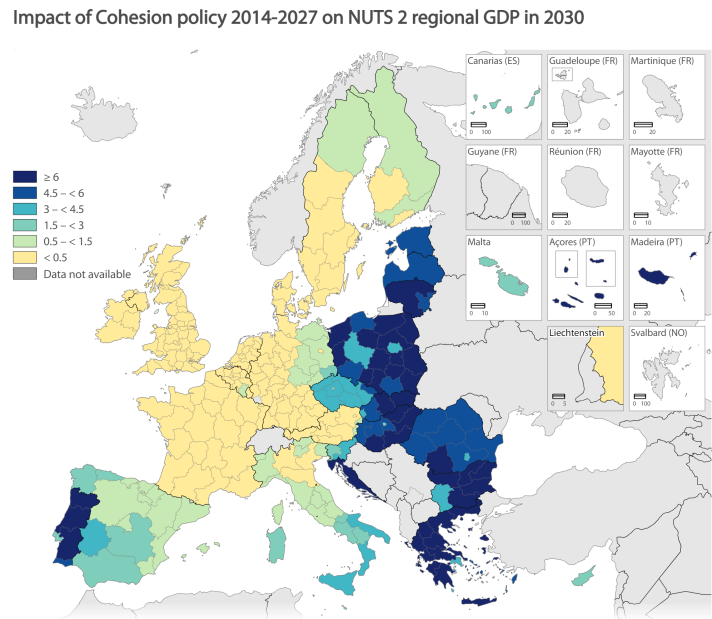
Cohesion Policy plays a key role in reducing regional disparities in the EU, helping less developed regions to catch up with the more developed ones, and overall promoting economic, social, and territorial convergence across the EU.
A modelling exercise carried out jointly by the JRC and the Commission’s Directorate General for Regional and Urban Policy (DG REGIO) shows that by 2030, each euro invested during the 2014-2020 and 2021-2027 Cohesion Policy funding programmes will have generated an additional €1.3 and will have almost tripled by 2043. These findings fed into the 9th Report on Economic, Social and Territorial Cohesion, published on 27 March 2024.
The 9th Cohesion Report includes evidence-based data and uses a wide range of indicators and perspectives in its analysis. The JRC contributed extensively: from the development and maintenance of the Annual Regional Database of the European Commission (ARDECO) – one of the main data sources for the Report’s analyses on population, employment, economic growth and migration - to research on urbanisation trends, rural areas, mobility, smart specialisation strategies, digitalisation, foreign direct investment or the impact of the twin green and digital transition on employment.
Positive impact for beneficiaries and contributors
The assessment of 2014-2027 Cohesion Policy shows a positive, yet varying impact across regions receiving funding, and for countries who are net contributors. The assessment was carried out with RHOMOLO, a dynamic general equilibrium model developed and maintained by the JRC in cooperation with the DG REGIO.
The positive impact is partly due to spillover between regions: interventions in a particular region also bring benefit to other regions in the EU, especially to the ones with strong trade links with the main beneficiaries.
The results show that the coefficient of variation, which measures the extent of regional differences in terms of GDP per capita, declines by about 3% in 2030, when the positive impact of the 2014-2027 interventions reaches its peak.
Regional disparities decline both at EU level and within most of its Member States. The impact per euro spent is greater in regions with a strong export basis and with smaller private and public capital endowments.
The analysis considers the funds allocated in two consecutive programming periods, as financial support is never interrupted between them. The budget allocated to Cohesion Policy for the period 2014-2020 is €356 billion (€405 billion with REACT-EU) and €376 billion for the period, 2021-2027.
The role of smart specialisation governance
JRC also looked into the impact of smart specialisation strategies. They are a precondition to access Cohesion Policy funding for research and innovation in the 2014-2020 programming period.
A combination of survey data on smart specialisation governance and the RHOMOLO spatial general equilibrium model showed that improving weak or underdeveloped governance of smart specialisation strategies significantly increases the investment-related impact of the policy.
The evidence stems from a case study of Italy’s 21 regions. Given the different level of development of Italy’s regions, the findings provide a useful insight for a wider EU context and indicate a need for targeted interventions in regions where the quality of policy governance lags behind.
Addressing demographic change
For over a century, the EU’s population has increasingly concentrated in cities and larger towns. After decades of growth, since 2020 it has also been declining. JRC work furthers our understanding of population changes over time – which is necessary to deploy effective territorial policies and to improve access to services for all.
A novel measurement of urbanisation trends shows that the population living in urban areas has increased from 59% to 71% between 1961 and 2021 – the first in-depth analysis on such a long time series. In parallel, the definition of functional rural areas can inform policies that improve the quality of life in these territories.
Climate change impact risks deepening of regional disparities but a territorial approach to the green transition can help less developed regions
Over 1% of GDP annually is at risk of being lost in coastal, Mediterranean, and south-eastern regions due to climate change, highlighting the uneven impact across the EU.
The green transition, essential to reduce climate impacts, challenges regions unevenly. Capital regions with high population density have the lowest greenhouse gas emissions per person, while regions with heavy industry have the highest, highlighting significant regional differences in efforts to reduce emissions.
The transition to green jobs threatens to exacerbate regional inequalities, as green jobs account for 25% of employment in the more developed regions, but only for 7% in the less developed regions. In addition, extending EU’s emission trading system to fuels for heating buildings and transport presents a tangible climate action opportunity but challenges low-income, rural households and micro-enterprises that spend more on these necessities.
While rural areas continue to face growth and development challenges, the Cohesion Report highlighted how they can simultaneously contribute to the green transition. A featured JRC report posits the potential of rural areas as the EU’s green powerhouse. It shows that rural areas already generate the largest share of electricity (72%) from renewable energy technologies and they hold nearly 80% of the untapped potential of renewable electricity production.
Related links
A RHOMOLO assessment of 2014-2027 cohesion policy
The impact of the 2014–2020 European Structural Funds on territorial cohesion
The economic implications of Smart Specialisation governance
Measuring transition to a competitive and sustainable economy
Details
- Publication date
- 11 April 2024
- Author
- Joint Research Centre
- JRC portfolios


